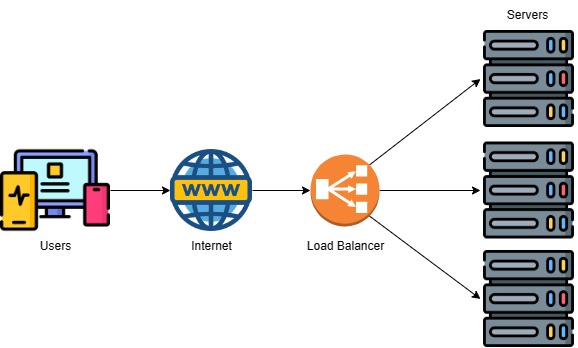Load Balancing
Contents
Load Balancing#
A load balancer is a crucial component of modern computer networks and data centers. Its primary function is to distribute incoming client requests across multiple server nodes to ensure efficient resource utilization, optimize performance, and provide high availability and fault tolerance. Load balancers play a vital role in scaling services and applications to handle varying levels of traffic and provide protection against Distributed Denial of Service (DDoS) attacks by distributing and managing incoming traffic effectively.

Load balancers are often categorized into two main types based on the layers of the OSI (Open Systems Interconnection) model at which they operate: Layer 4 load balancers and Layer 7 load balancers (also known as content switches).
Layer 4 Load Balancer#
A Layer 4 load balancer operates at the transport layer (Layer 4) of the OSI model. It makes load balancing decisions based on information available in the transport layer header of the network packets, such as the source IP address and port, destination IP address and port, and protocol (TCP or UDP). Layer 4 load balancers are primarily concerned with routing and forwarding traffic to backend servers based on this limited information.
Since Layer 4 load balancers don’t inspect the contents of the application payload, they are best suited for applications that can be distributed based on IP addresses or port numbers. Typical use cases for Layer 4 load balancing include simple TCP or UDP-based services like DNS, SMTP, and generic web traffic where session persistence (sticky sessions) may not be a strict requirement.
Layer 7 Load Balancer (Content Switch)#
A Layer 7 load balancer operates at the application layer (Layer 7) of the OSI model. It can make load balancing decisions based on more detailed information within the application payload, such as the HTTP headers, cookies, or even the content of the HTTP request itself. Layer 7 load balancers are more application-aware and can intelligently distribute traffic based on specific application attributes.
The ability to inspect and interpret application-level data allows Layer 7 load balancers to perform more advanced load balancing techniques, such as session affinity (sticky sessions) and content-based routing. Session affinity ensures that requests from the same client are directed to the same backend server, which is crucial for maintaining session state in applications that are not entirely stateless.
Layer 7 load balancers are ideal for applications that require advanced traffic distribution based on application-specific requirements. They are commonly used for HTTP/HTTPS-based applications like web servers, API gateways, and other application services that rely on HTTP-based communication.
Load balancers are implemented in various environments to distribute client requests across multiple server nodes efficiently. Some examples of load balancer implementations in different scenarios are described below:
1. Hardware Load Balancer Appliance: Large-scale data centers and enterprise networks often use dedicated hardware load balancer appliances. These appliances are standalone devices specifically designed for load balancing tasks. Examples of hardware load balancer vendors include F5 Networks, Citrix NetScaler (now known as Citrix ADC), and Barracuda Networks.
2. Software Load Balancer in Cloud Environments: Cloud service providers offer load balancing services that can be easily deployed and configured to distribute traffic across virtual machines or instances in the cloud. For instance, Amazon Web Services (AWS) provides Elastic Load Balancing (ELB), which includes Classic Load Balancer (Layer 4) and Application Load Balancer (Layer 7) options. Google Cloud Platform (GCP) offers Google Cloud Load Balancing, and Microsoft Azure provides Azure Load Balancer and Azure Application Gateway.
3. Open Source Software Load Balancers: There are several open-source load balancer solutions available for those who prefer a cost-effective option or want to have more control over the implementation. Some popular open-source load balancer projects include Nginx, HAProxy, and Apache HTTP Server with mod_proxy_balancer module.
It’s worth noting that many modern load balancers are designed to operate at both Layer 4 and Layer 7, providing a combination of transport-layer and application-layer load balancing functionalities. This flexibility allows them to handle a wide range of applications and services efficiently while providing the necessary scalability, performance, and security features.
